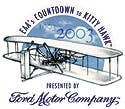
The Wright brothers rose early from their ceiling-high beds on December 17, 1903. Outside it was cold and clear, with a frigid 24-mph wind blowing out of the north, and the puddles of water from a recent rain were covered with ice. Hoping the wind would die down, the Wrights went back inside. When there was no change by 10 a.m., they decided to attempt a flight nonetheless. After hoisting the red signal flag to summon the men from the Life Saving Station, they hauled out sections of launch rail and tacked them into the sand on a smooth stretch near the glider shed, then returned inside to warm up again.
At 10:20 a.m., the Lifeguards arrived and helped the brothers carry the 605-pound machine from the shed and set it on the rail. At 10:27 a.m., Wilbur instructed John Daniels to man the large box camera he had set up between the buildings and machine. "As soon as the machine gets to the end of the rail, you just squeeze the bulb," he said.
|| |---| | | | The camera that captured man's first moment of powered flight.| After that, it all happened quickly. A few drops of gas were pumped into each cylinder of the engine. The battery box was connected to it. Wilbur and Orville pulled the propellers, and the engine coughed to life. Solemnly, the two brothers shook hands. Then Orville climbed in, shifted his hips to check the wing-warping and rudder mechanisms, then moved the elevator up and down.
At 10:35 a.m., Orville slipped off the rope restraining the Flyer and the machine moved down the track, gathering speed to 30 mph and then … lifting into the air! As instructed, Daniels squeezed the camera bulb, unaware he was taking one of the most famous photos in history. The small group watching exploded into a ragged cheer. For 12 seconds, the airplane floundered forward, rising and falling, until it finally struck the sand 120 feet from the point it left the rails.
The others raced forward to congratulate Orville, then carried the machine back for more attempts. At 11:20 a.m., Wilbur also flew for 12 seconds but went 195 feet. At 11:40 a.m., Orville was up for 15 seconds and 200 feet. At noon, Wilbur turned in a remarkably even flight -soaring 852 feet in 59 seconds. Might they not make an even longer flight, he wondered, all the way to the telegraph office at Kitty Hawk?
|| |---| | | | Wilbur watches as Orville and the Flyer lift into the air.| As the men were talking, fate intervened, when a huge gust of wind overturned the Flyer, damaging it so badly it was of no further use. No matter. The point was the Wrights had done it! History had been made. For the first time, man had flown a machine that raised itself by its own power into the air, sailed forward without reduction in speed and finally landed at a point as high as that from which it had started.
Basking in the satisfaction of their accomplishment, the Wrights ate a leisurely lunch, then walked down to the telegraph office and sent the following to their father, Bishop Milton Wright, in Dayton:
"Success four flights Thursday morning # all against twenty one mile wind started from Level with engine power alone # average speed through air thirty one miles longest 57 seconds inform Press home # Christmas. Orevelle Wright."
A sending error had knocked two seconds off the time, and Orville's name was misspelled. But the message to the Bishop was clear. They had done it_._
This "Kitty Hawk Moment" is brought to you by the EAA, whose Countdown to Kitty Hawk program, presented by Ford Motor Company, includes an exact flying reproduction of the Wright Flyer. It is the centerpiece of the EAA's national tour during 2003, which will conclude with a five-day celebration at Kitty Hawk, North Carolina, where the Wright Flyer will fly again at exactly 10:35 a.m. on December 17, 2003, commemorating 100 years of powered flight.
www.countdowntokittyhawk.org

Sign-up for newsletters & special offers!
Get the latest FLYING stories & special offers delivered directly to your inbox






